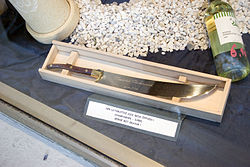- Sabrage
-
Sabrage is a technique for opening a Champagne bottle with a sabre,[1] used for ceremonial occasions. The saber is slid along the body of the bottle toward the neck. The force of the blade hitting the lip breaks the glass to separate the collar from the neck of the bottle. The cork and collar remain together after separating from the neck.
Contents
History
This technique became popular in France when the army of Napoleon visited many of the aristocratic domains. It was just after the French Revolution and the saber was the weapon of choice of Napoleon's fearsome light cavalry (the Hussars). Napoleon's spectacular victories across all Europe gave them plenty of reason to celebrate. During these parties the cavalry would open the Champagne with their sabers. Napoleon, known to have said, "Champagne! In victory one deserves it; in defeat one needs it."[2] may have encouraged this.
There are many stories about this tradition. One of the more spirited tales is that of Madame Clicquot, who had inherited her husband's small Champagne house at the age of 27. She used to entertain Napoleon's officers in her vineyard, and as they rode off in the early morning with their complimentary bottle of Champagne, they would open it with their saber to impress the rich young widow.
Champagne sword
A Champagne sword (sabre à Champagne) is an instrument specially made for sabrage. Some swords have short blades, around 12 inches (30 cm) long[3] and resemble large knives, although others have longer blades.[4] The blades are completely blunt – a sharpened edge is unnecessary as the bottle is struck with the back of the blade.[3]
The bottle neck is held at an angle of approximately 20 degrees and the sword is cast down on it. The experienced sommelier can open the bottle with little loss of Champagne. However, it is advised to allow a small flow in order to wash away any loose shards of glass that may be adhering to the neck. The first glass poured should also be checked for small glass shards.[5]
Physics of sabrage
A Champagne bottle holds a considerable amount of pressure. Early bottle designs tended to explode, and the manufacturers kept making them thicker until they could contain the pressure that is caused by the release of carbon dioxide during the fermentation. The inside pressure of a typical Champagne bottle will be around 90 pounds per square inch (620 kPa). The diameter of the opening is 0.7 inches (18 mm), so there is a force of about 35 pounds-force (160 N) trying to push the cork out of the bottle.
At the opening of the bottle, there is a lip that creates a stress concentration. On the vertical seam of the bottle the glass is not as uniform, which creates a second stress concentration. At the intersection of the seam and the lip, both stress concentrations combine and the strength of the glass is cut by more than fifty percent. The impact of the saber on this weak point creates a crack that rapidly propagates through the glass, fueled by the momentum of the saber and the pressure in the bottle. Once the crack has severed the top from the bottle, the pressure inside the bottle and the transferred momentum from the saber will send the top flying, typically for a distance of 5–10 metres (16–33 ft).
Competition
There is currently no world championship in Sabrage. The only way to measure skill is with a Guinness World Records with the categories: Most champagne bottles sabered in one minute - 32 and was achieved by Julio Gonzalo Chang Romero (Spain) in Marbella, Spain, on 18 April 2011 [6] and Most champagne bottles sabered simultaneously - Achieved by 152 participants in an event organised by International Sabrageurs Anonymous in Portarlington, Co. Laois, Ireland, on 18 July 2009
References
- ^ Ma, Amy (October 27, 2010). "Wine 101: The Art of Sabering". The Wall Street Journal. http://blogs.wsj.com/scene/2010/10/27/wine-101-the-art-of-sabering/.
- ^ http://wineintro.com/champagne/quotes.html
- ^ a b "Sabre à Champagne Selection". SabreaChampagne.Com. http://www.sabreachampagne.com/products.html. Retrieved December 29, 2010.
- ^ "WKC Champagne Sword". WKC. http://www.champagner-saebel.de/english/index.html. Retrieved December 29, 2010.
- ^ (in English) How To Open A Bottle Of Champagne With A Sword (Motion picture). Videojug. 2007-01-05. http://www.videojug.com/film/how-to-open-a-bottle-of-champagne-with-a-sword. Retrieved 2011-01-01.
- ^ http://www.typicallyspanish.com/news/publish/article_30134.shtml
External links
Categories:- Champagne (wine)
- Etiquette
- Sparkling wines
Wikimedia Foundation. 2010.


